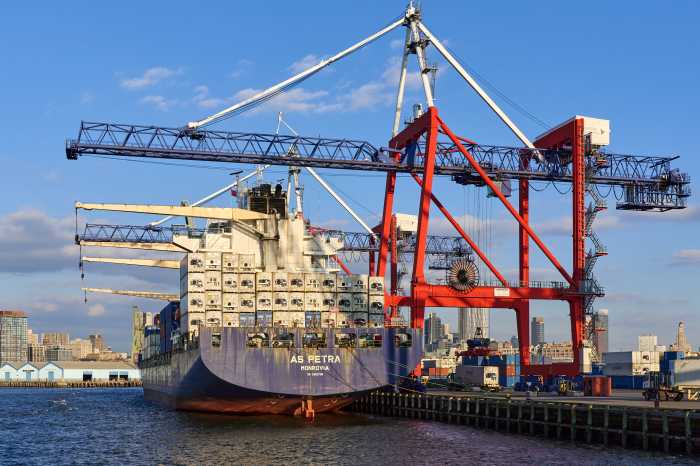By Ronda Kaysen
With the closing date for the sale of NYU Downtown Hospital’s Beekman St. parking lot to Forest City Enterprises looming, residents of nearby Southbridge Towers have launched negotiations of their own with developer Bruce Ratner in the hopes of securing amenities for their own building — to the dismay of some Community Board 1 members.
Members of the board’s Seaport/Civic Center committee drafted a resolution at an Oct. 12 meeting calling for community solidarity in dealings with Ratner and his plans for a 75-story multi-use tower on the site. If built, the Frank Gehry-designed tower will be the second tallest building Downtown after the Freedom Tower.
No amenities have been secured for the community as of yet, and City Councilmember Alan Gerson insists that once the deal closes (perhaps by the end of the month) the community will have less leverage to secure any amenities at all. Residents of nearby 140-150 Nassau St. filed a lawsuit against Ratner earlier this month, which may delay the closing if a settlement is not reached.
Two weeks ago, residents of nearby Southbridge Towers entered into discussions of their own with Ratner that, according to committee members, may undermine the community’s ability to negotiate effectively with the developer. “We all need to be working together and we should be honest with each other as we move forward in this process,” said Paul Goldstein, C.B. 1’s district manager and a Southbridge resident. “Obviously the developer is using a strategy of divide and conquer to divide the community.”
But Southbridge’s interests are not in conflict with the community’s interests, according to Paul Viggiano, president of the Southbridge Towers co-op board. Southbridge board members met with Ratner a few weeks ago for an “initial meeting” but “there were no negotiations, there was nothing,” he insisted. “If I thought for a minute that anything that Southbridge would ask for would diminish any other efforts, I guess I would pull out because I don’t want that to happen,” Viggiano said in a telephone interview.
Although Viggiano declined to comment about what specific amenities Southbridge is seeking, he mentioned “floors and windows” as two possible amenities and other sources suggested that the co-op board was negotiating for a community room and small park for Southbridge.
Seaport/Civic Center committee members expressed concern that Southbridge may weaken C.B. 1’s leverage. “The community board has been representing the community and supporting the desires of the community for many years. We have to speak in one voice,” Marc Donnenfeld, the committee’s chairperson, said at the meeting. Individual negotiations are “going to weaken the community board in the long run,” he added.
According to Viggiano, Southbridge has every right to try to secure amenities of its own with Ratner. “I would be remised as the president of this board if I wasn’t able to go out and talk to Ratner about specifics to Southbridge,” he said. “Everyone seems to be going out and asking for what they want.”
Residents of 140-150 Nassau St. stepped up its efforts to reach a deal with Ratner without the direct involvement of the community, says Viggiano, which has had the positive effect of “getting people to the bargaining table.” Residents of 140-150 Nassau St. approached Southbridge Towers regarding the lawsuit, but they declined to participate.
The 140-150 Nassau St. lawsuit, however, will not have a negative effect on community negotiations, says Goldstein of C.B. 1, because it calls for a Uniform Land Use Review Procedure and an environmental impact study for the tower, two processes that would require public review. Gerson also expressed his support for the lawsuit and said he may file a friend of the court brief in the event that negotiations break down.
Nassau St. residents are most interested in securing a plaza between their building and the Ratner building so the new tower will not block their windows, according to sources close to the suit.
Ratner did not return repeated calls for comment for this story.
According to Gerson, the financially strapped NYU Downtown Hospital insists it will be forced to file for bankruptcy if the lot is not sold by the closing date. If the hospital files for bankruptcy, it will be turned over to the New York State Department of Health. “I think the way it’s been handled is awful,” said Gerson at the meeting. “What assurance do we have that in years in the future they’re not going to be in the same straits?”
Bruce D. Logan, president and C.E.O. of Downtown Hospital, said the hospital has no immediate plans to file for bankruptcy. “NYU Downtown Hospital, like most hospitals operating in the current healthcare environment, is facing very severe financial difficulties,” Logan wrote in an e-mail statement. “However, in the event that the sale of the parking lot does not close by the end of the month, the hospital absolutely will not file for bankruptcy protection.“
The site was set aside for public use for NYU Downtown Hospital in 1964 after it had been taken over by the city under eminent domain. When the statue of limitations on use and height restrictions expired this year, Ratner began negotiations to purchase the property from the hospital. The tower’s architect, Frank Gehry, was tapped this week to design the theater cultural building in the new World Trade Center.
Partially financed by $243 million in commercial Liberty Bonds, Pace University will occupy 330,000 square feet on the lower 24 floors of the Beekman St. tower and 25,000 square feet will be reserved for an outpatient facility for the hospital. The remaining space will include rental and condo apartments. C.B. 1 hopes to secure 50,000 square feet for a community facility with a pool and health center.
C.B. 1 will vote on the resolution at its Oct. 19 full board meeting.
Ronda@DowntownExpress.com
WWW Downtown Express
Read More: https://www.amny.com/news/bars-clubs-42/

































